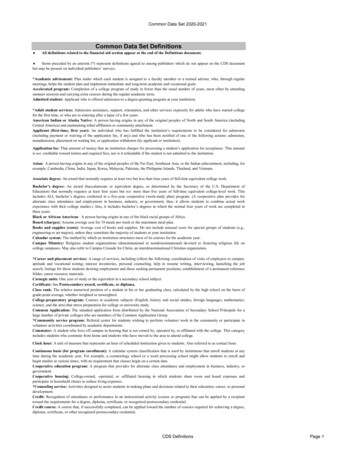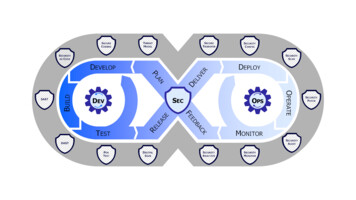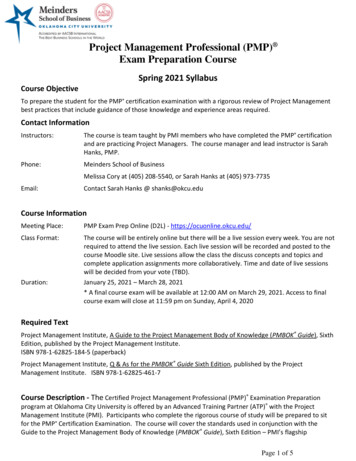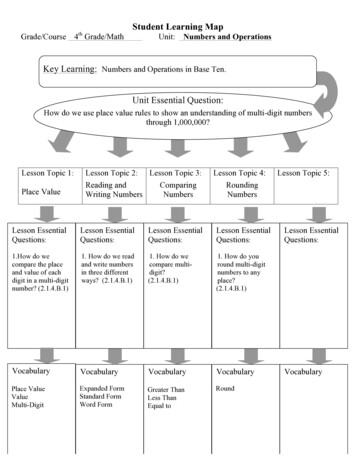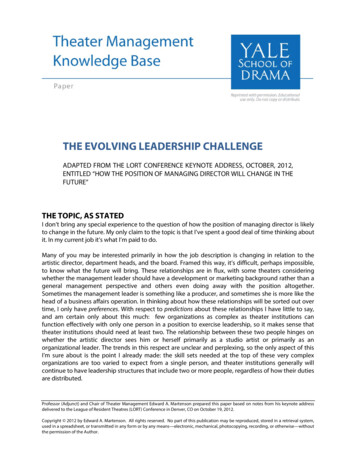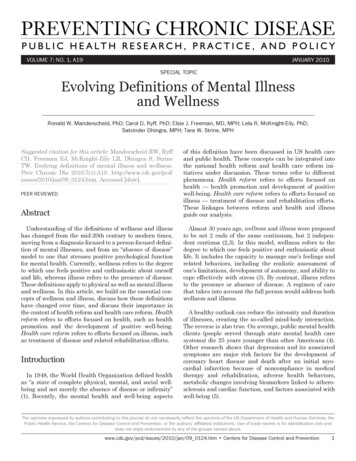
Transcription
VOLUME 7: NO. 1, A19JANUARY 2010SPECIAL TOPICEvolving Definitions of Mental Illnessand WellnessRonald W. Manderscheid, PhD; Carol D. Ryff, PhD; Elsie J. Freeman, MD, MPH; Lela R. McKnight-Eily, PhD;Satvinder Dhingra, MPH; Tara W. Strine, MPHSuggested citation for this article: Manderscheid RW, RyffCD, Freeman EJ, McKnight-Eily LR, Dhingra S, StrineTW. Evolving definitions of mental illness and wellness.Prev Chronic Dis 2010;7(1):A19. http://www.cdc.gov/pcd/issues/2010/jan/09 0124.htm. Accessed [date].PEER REVIEWEDAbstractUnderstanding of the definitions of wellness and illnesshas changed from the mid-20th century to modern times,moving from a diagnosis-focused to a person-focused definition of mental illnesses, and from an “absence of disease”model to one that stresses positive psychological functionfor mental health. Currently, wellness refers to the degreeto which one feels positive and enthusiastic about oneselfand life, whereas illness refers to the presence of disease.These definitions apply to physical as well as mental illnessand wellness. In this article, we build on the essential concepts of wellness and illness, discuss how these definitionshave changed over time, and discuss their importance inthe context of health reform and health care reform. Healthreform refers to efforts focused on health, such as healthpromotion and the development of positive well-being.Health care reform refers to efforts focused on illness, suchas treatment of disease and related rehabilitation efforts.IntroductionIn 1948, the World Health Organization defined healthas “a state of complete physical, mental, and social wellbeing and not merely the absence of disease or infirmity”(1). Recently, the mental health and well-being aspectsof this definition have been discussed in US health careand public health. These concepts can be integrated intothe national health reform and health care reform initiatives under discussion. These terms refer to differentphenomena. Health reform refers to efforts focused onhealth — health promotion and development of positivewell-being. Health care reform refers to efforts focused onillness — treatment of disease and rehabilitation efforts.These linkages between reform and health and illnessguide our analysis.Almost 30 years ago, wellness and illness were proposedto be not 2 ends of the same continuum, but 2 independent continua (2,3). In this model, wellness refers to thedegree to which one feels positive and enthusiastic aboutlife. It includes the capacity to manage one’s feelings andrelated behaviors, including the realistic assessment ofone’s limitations, development of autonomy, and ability tocope effectively with stress (3). By contrast, illness refersto the presence or absence of disease. A regimen of carethat takes into account the full person would address bothwellness and illness.A healthy outlook can reduce the intensity and durationof illnesses, creating the so-called mind-body interaction.The reverse is also true. On average, public mental healthclients (people served through state mental health caresystems) die 25 years younger than other Americans (4).Other research shows that depression and its associatedsymptoms are major risk factors for the development ofcoronary heart disease and death after an initial myocardial infarction because of noncompliance in medicaltherapy and rehabilitation, adverse health behaviors,metabolic changes involving biomarkers linked to atherosclerosis and cardiac function, and factors associated withwell-being (5).The opinions expressed by authors contributing to this journal do not necessarily reflect the opinions of the US Department of Health and Human Services, thePublic Health Service, the Centers for Disease Control and Prevention, or the authors’ affiliated institutions. Use of trade names is for identification only anddoes not imply endorsement by any of the groups named above.www.cdc.gov/pcd/issues/2010/jan/09 0124.htm Centers for Disease Control and Prevention
VOLUME 7: NO. 1JANUARY 2010Definitions of Mental IllnessDefinitions of mental illnesses have changed over thelast half-century. Mental illness refers to conditions thataffect cognition, emotion, and behavior (eg, schizophrenia, depression, autism). Formal clinical definitions nowinclude more information (ie, we have moved from a partial to a more holistic perspective and transitioned froma focus on disease to a focus on health). The informalresponse has fostered a parallel transition from a focuson the stigma of mental illnesses to the recognition thatmental health is important to overall health.In the 1960s and 1970s, a person with a mental illnesswas defined by diagnosis alone, and there were few broadclasses of mental disorders. National statistical data werereported by diagnoses (eg, cases of schizophrenia and casesof depression). People with mental illness were commonlystigmatized and institutionalized. At the same time, deinstitutionalization had begun and was accelerating.A major shift occurred in care practices during the1980s and 1990s. The national approach to care forpeople with severe mental illnesses was failing to supporttheir needs. Large numbers of people with severe mentalillnesses had been released from state mental hospitals,but few community mental health services were availableto serve them. The population of homeless mentally illpeople was growing rapidly. New definitions were neededto identify people with the most severe mental illnessesand to create a framework for new national programs.The formal work of the National Institute of MentalHealth (NIMH) showed that diagnosis alone was notsufficient, and the additional concepts of disability andduration were added. Disability referred to major limitations in personal activities, and duration referred to theduration of disability and had a minimum threshold of1 year. These concepts informed a definition for peoplewith “severe and persistent mental illnesses,” which isstill used in mental health (6).Subsequently, these efforts were extended to includeanother population with mental illnesses associated withlesser disabilities, and duration was removed from thedefinition. Currently, the person is viewed as paramount;strengths are emphasized and weaknesses de-emphasized. Recovery and full community participation arethe goals. Here, recovery is a life-long process in which aperson with a mental illness strives to participate fully incommunity life, even in the presence of continuing symptoms and disabilities.These recent definitions use the wellness model, inwhich health and disease are viewed as 2 separatedimensions. Recovery is the bridge between the 2 thatbuilds on the strengths of health to address the weaknesses of disease. Because many people with mental illnesses also have physical disorders, a dual emphasis onmental and physical health is essential. These emphases will be very important for health reform and healthcare reform.The primary manuals used by epidemiologists, healthmanagement officials, and clinicians for mental diseaseclassification are the American Psychiatric Association’sDiagnostic and Statistical Manual of Mental Disorders(DSM), now in its 4th version (7), and the World HealthOrganization’s Manual of the International StatisticalClassification of Diseases, Injuries, and Causes of Death(ICD), currently in its 10th version (8). Previous versionsof the DSM and ICD have not been fully congruent so thatthe same diagnoses are listed in both systems. However,practitioners and insurers increasingly need to be conversant with both systems, especially in light of the new evidence on interactions between physical and mental health.Thus, the DSM-V Task Force has been developing the nextedition to more closely align it with the ICD-11.Response, Remission, and RelapseDepression is an important marker condition becauseit frequently co-occurs with a range of substance use andphysical disorders. The NIMH Collaborative DepressionStudy (CDS) defined the desirable clinical endpoints ofremission and recovery among people with depression(9). Response refers to a clinically significant reduction indepressive symptoms, whereas remission refers to the virtual absence of depressive symptoms after a response. Relapserefers to a return of depressive symptoms after remission,and recovery refers to sustained remission, with or withoutconcurrent treatment; a return of depressive symptomsafter recovery is a recurrence. These concepts can be used todescribe the dynamics of any mental illness.Several recent studies have shown that even subthreshold or minor depression is often associated withdisability and poor psychosocial functioning, and a poten-The opinions expressed by authors contributing to this journal do not necessarily reflect the opinions of the US Department of Health and Human Services, thePublic Health Service, the Centers for Disease Control and Prevention, or the authors’ affiliated institutions. Use of trade names is for identification only anddoes not imply endorsement by any of the groups named above. Centers for Disease Control and Prevention www.cdc.gov/pcd/issues/2010/jan/09 0124.htm
VOLUME 7: NO. 1JANUARY 2010tially more severe course that requires treatment (10).If left untreated or inadequately treated, depression canbe a source of unnecessary personal distress, prolongedfamily burden, and a substantial number of illnesses anddeaths (11).Definitions of Mental HealthOne of the most significant developments of recentdecades has been the emergence of theoretically based,empirically validated assessments of positive psychologicalfunctioning, including a sense of well-being and hope. Oneprecursor, beginning in the 1950s and known as the “socialindicators movement,” pertained to quality of life (12).Several landmark studies described quality of life with afocus on how it varied by demographic characteristics andwhether it changed across time (13).Following this societal perspective, psychologistsincreased interest in the topic of subjective well-being,delineated its component parts (eg, life satisfaction, ratings of happiness), and investigated the influences ofjudgmental and motivational processes (14,15). Othersapproached psychological functioning from humanistic,existential, and life-span developmental perspectives thatemphasized growth, meaning, and personal capacity (16).These formulations evolved into 2 broad orientations fordefining psychological well-being: 1 focused on happinessand the other on human potential (17-19).Further impetus came from the positive psychologymovement (20) and many products following from it (21).These products cover wide territories of psychologicalexperience: compassion, control, creativity, love, optimism,resilience, spirituality. Some of these human strengthsrepresent well-developed areas of scientific inquiry, andothers point to new areas for future studies. Two types ofresearch are needed: 1) population-level studies on the distribution of well-being across society strata and 2) studiesshowing that well-being affects morbidity, mortality, andintervening biological processes.In the past decade, psychological well-being has beeninvestigated in national studies using empirical indicatorssuch as life satisfaction, purpose, personal growth, environmental mastery, self-acceptance, autonomy, and positiverelationships (22). As these studies document, the absenceof mental distress does not guarantee the presence of well-being (ie, as specified above, mental illness and mentalhealth are independent dimensions). In addition, thesestudies have clarified that psychological well-being is notequitably distributed in American society — older adultsand people lacking educational attainment report lowerlevels of purpose, mastery, and growth (19), although insome instances, ethnic and minority status confers protective factors relative to social determinants (23).New research has probed the idea that positive mental health may influence physical health and biologicalfunctioning. A recent review (24) summarizes evidenceshowing that high positive affect (measured in terms ofhappiness, joy, contentment, and enthusiasm) is linkedwith lower morbidity, increased longevity, and reducedhealth symptoms. Positive emotional style was alsoassociated with better endocrine function (lower levels ofcortisol, epinephrine, norepinephrine) and better immuneresponse (higher antibody production, greater resistanceto illness) (25). Similar findings have been reported linking positive affect to lower inflammatory response andlower blood pressure. Indicators of well-being have alsobeen linked to biology. Older women with higher levelsof purpose in life, personal growth, and positive relationships had lower cardiovascular risk (lower glycosylatedhemoglobin, lower weight, lower waist-hip ratios, higherHDL cholesterol) and better neuroendocrine regulation(lower salivary cortisol throughout the day) (26). Thosewith positive relationships and purpose in life had lowerinflammatory factors (eg, interleukin 6 [IL-6] and itssoluble receptor [sIL-6r]) (27). Psychological well-beinghas been linked with brain function and asymmetricactivation of the prefrontal cortex (28) and with reducedamygdala activation to aversive stimuli, accompanied bygreater activation of the ventral anterior cingulated cortex (29). These advances clarify how well-being can arisein neural function.If positive mental health is linked with better biologicalregulation and improved neural response to negative stimuli, can well-being be promoted among those who do notnaturally possess such life outlooks or suffer from mentalillness? Fava (30) examined “well-being therapy,” whichinvolves keeping a focus (through daily diaries) on positiveexperience and learning how to elaborate and savor suchexperience. This treatment has been linked with improvedremission profiles among those suffering from recurrentdepression. Fava also showed that such improvement persisted over a 6-year follow-up period.The opinions expressed by authors contributing to this journal do not necessarily reflect the opinions of the US Department of Health and Human Services, thePublic Health Service, the Centers for Disease Control and Prevention, or the authors’ affiliated institutions. Use of trade names is for identification only anddoes not imply endorsement by any of the groups named above.www.cdc.gov/pcd/issues/2010/jan/09 0124.htm Centers for Disease Control and Prevention
VOLUME 7: NO. 1JANUARY 2010Social Determinants of Mental Health andIllnessMental health and mental illnesses can both cause andbe influenced by positive or negative social determinantsof health (described further by Primm et al in this issue)defined as “the specific features of and pathways by whichsocietal conditions affect health and that potentially canbe altered by informed action” (31). These determinantsinclude income, housing, stress, early childhood experiences, social exclusion, occupation, education level, sanitation, social support, discrimination (eg, racism), and lackof access to resources. Mental health promotion mustconsider the broad-scale social factors that can interactwith biological determinants of mental illnesses. Negativedeterminants are often disproportionately distributedamong minority populations, placing them at greater riskfor the development of mental and physical illness andrelated mortality (32).DiscussionOur views have clear implications for health reformand for health care reform. First, several studies showthat mental health is frequently intertwined with physical health and social conditions; attempts to understanddifferent diseases, develop interventions, and designhealth promotion strategies will be more effective ifrooted in a dynamic and complex biopsychosocial modelof disease and health. Second, recent studies show thathigher levels of well-being are linked with better regulation of biological systems and adaptive neural response,and may serve as a protective influence on good physicalhealth. Third, different approaches are required for different subpopulations. The subpopulation with seriousmental illnesses comprises only about one-quarter of alladults with a mental illness each year. The subpopulation with other mental illnesses, 75% of all adults witha mental illness each year, also requires a care systemthat addresses its service needs. Further, at any one time,substantial numbers of a third subpopulation are suffering from subsyndromal states or nonspecific psychological distress. Developing interventions that support thesedifferent subpopulations may have implications for theprevention of diagnosable and impairing mental illnessesand physical illnesses, and for recovery. Fourth, recoveryis an important process that bridges illness and wellness(33); it deserves greater attention in the future.Unfortunately, most evidence-based interventionsonly address mental illnesses and are seen as the province of mental health specialists. Yet primary care providers oversee most mental health care for the generalpopulation; they are essential partners in addressingphysical health issues for both public mental healthclients and the general population with less disablingmental illness.For those with mental illnesses, the major concern ofhealth care reform is promoting illness care based onwellness and well-being; recovery is a key concept. Themajor focus of health reform should be to promote wellness and well-being. Linked approaches can improveoverall health, delay onset of chronic diseases, and enablepersonal success in family, community, and work.The Centers for Disease Control and Prevention (CDC)and the Substance Abuse and Mental Health ServicesAdministration (SAMHSA) can provide joint leadership in implementing the needed interventions. CDChas expertise in approaches to wellness and well-being;SAMHSA, in recovery-oriented, strength-based care. Werecommend that CDC and SAMHSA undertake jointwork guided by the vision of delaying the onset andmitigating the effects of mental illnesses, and promotingpositive mental and physical health.Author InformationCorresponding Author: Ronald W. Manderscheid, PhD,Director, Mental Health and Substance Use Programs,Global Health Sector, SRA International, Inc, 6003Executive Blvd, Suite 400, Rockville, MD 20852. Telephone:240-514-2607. E-mail: ronald manderscheid@sra.com. DrManderscheid is also affiliated with the Bloomberg Schoolof Public Health, Johns Hopkins University, Rockville,Maryland.Author Affiliations: Carol D. Ryff, University ofWisconsin-Madison, Madison, Wisconsin; Elsie J. Freeman,Maine Department of Health and Human Services,Augusta, Maine; Lela R. McKnight-Eily, SatvinderDhingra, Tara W. Strine, Centers for Disease Control andPrevention, Atlanta, Georgia.The opinions expressed by authors contributing to this journal do not necessarily reflect the opinions of the US Department of Health and Human Services, thePublic Health Service, the Centers for Disease Control and Prevention, or the authors’ affiliated institutions. Use of trade names is for identification only anddoes not imply endorsement by any of the groups named above. Centers for Disease Control and Prevention www.cdc.gov/pcd/issues/2010/jan/09 0124.htm
VOLUME 7: NO. 1JANUARY 2010References1. World Health Organization. Preamble to the constitution of the World Health Organization as adopted bythe International Health Conference. New York, 19-22June, 1946; signed on 22 July 1946 by the representatives of 61 States (Official Records of the World HealthOrganization, no. 2, p. 100) and entered into force on 7April 1948.2. Ng LKY, Davis DD, Manderscheid RW, Elkes J.Toward a conceptual formulation of health and wellbeing. In: Ng LKY, Davis DL, editors. Strategies forpublic health: promoting health and preventing disease. New York (NY): Van Nostrand Reinhold; 1981.p. 44-58.3. Manderscheid RW. Saving lives and restoring hope.Behav Healthc 2006;26(9):58-9.4. Colton CW, Manderscheid RW. Congruencies inincreased mortality rates, years of potential life lost,and causes of death among public mental healthclients in eight states. Prev Chronic Dis 5 0180.htm.Accessed September 2, 2009.5. Goodwin FK, Jamison KR. Bipolar disorder and recurrent depression, 2nd edition. New York (NY): OxfordUniversity Press; 2007.6. Grob GN. The mad among us: a history of the careof America’s mentally ill. New York (NY): Simon andShuster; 1995.7. Diagnostic and statistical manual of mental disorders,4th edition, text revision. Washington (DC): AmericanPsychiatric Association; 2000.8. ICD-10: international statistical classification of diseases and related health problems: tenth revision.2nd edition. Geneva, Switzerland: World HealthOrganization; 2004.9. Keller MB, Shapiro RW, Lavori PW, Wolfe N. Relapsein major depressive disorder: analysis with the lifetable. Arch Gen Psychiatr 1982;39(8):911-5.10. Judd LL, Akiskal HS, Zeller PJ, Paulus M, Leon AC,Maser JD, et al. Psychosocial disability during thelong-term course of unipolar major depressive disorder. Arch Gen Psychiatr 2000;57(4):375-80.11. Trivedi MH, Rush AJ, Wisniewski SR, Warden D,McKinney W, Downing M, et al. Factors associatedwith health-related quality of life among outpatientswith major depressive disorder: a STAR*D report. JClin Psychiatr 2006;67(2):185-95.12. Land KC. Theories, models and indicators of socialchange. Int Soc Sci J 1975;27:7-37.13. Andrews FM, Withey SB. Social indicators of wellbeing: America’s perception of life quality. New York(NY): Plenum; 1976.14. Diener E. Subjective well-being. Psychol Bull1984;95:542-75.15. Diener E, Suh EM, Lucas RE, Smith HL. Subjectivewell-being: three decades of progress. Psychol Bull1999;125(2):276-302.16. Neugarten BL. Personality change in late life: adevelopmental perspective. In: Eisodorfer C, LawtonMP, editors. The psychology of adult developmentand aging. Washington (DC): American PsychologicalAssociation; 1973. p. 311-35.17. Kahneman D, Diener E, Schwarz N, editors. Wellbeing: the foundations of hedonic psychology. NewYork (NY): Russell Sage Foundation;1999.18. Ryan RM, Deci EL. On happiness and human potentials: a review of research on hedonic and eudaimonicwell-being. Ann Rev Psychol 2001;52:141-66.19. Ryff CD, Singer BH. Know thyself and become whatyou are: a eudaimonic approach to psychological wellbeing. J Happiness Stud 2008;9(1):13-39.20. Seligman MEP, Csikszentmihalyi M. Positive psychology: an introduction. Am J Psychol 2000;55:51-82.21. Aspinwall LG, Staudinger UM, editors. A psychologyof human strengths: perspectives on an emerging field.Washington (DC): American Psychiatric Association;2002.22. Keyes CLM, Shmotkin D, Ryff CD. Optimizing wellbeing: the empirical encounter of two traditions. JPers Soc Psychol 2002;82(6):1007-22.23. Ryff CD, Keyes CLM, Hughes DL. Status inequalities,perceived discrimination, and eudaimonic well-being:do the challenges of minority life hone purpose andgrowth? J Health Soc Behav 2003;44(3):275-91.24. Pressman SD, Cohen S. Does positive affect influencehealth? Psych Bull 2005;131(6):925-71.25. Steptoe A, Gibson EL, Hamer M, Wardle J.Neuroendocrine and cardiovascular correlates of positive affect measured by ecological momentary assessment and by questionnaire. Psychoneuroendocrin2006;32(1):56-74.26. Ryff CD, Love GD, Urry HL, Muller D, RosenkranzMA, Friedman EM, et al. Psychological well-being andill-being: do they have distinct or mirrored biologicalcorrelates? Psychother Psychosom 2006;75(2):85-95.27. Friedman EM, Hayney MS, Love GD, Urry HL,Rosenkranz MA, Davidson RJ, et al. Social relation-The opinions expressed by authors contributing to this journal do not necessarily reflect the opinions of the US Department of Health and Human Services, thePublic Health Service, the Centers for Disease Control and Prevention, or the authors’ affiliated institutions. Use of trade names is for identification only anddoes not imply endorsement by any of the groups named above.www.cdc.gov/pcd/issues/2010/jan/09 0124.htm Centers for Disease Control and Prevention
VOLUME 7: NO. 1JANUARY 201028.29.30.31.32.33.ships, sleep quality, and interleukin-6 in aging women.Proc Natl Acad Sci USA 2005;102(51):18757-62.Urry HL, Nitschke JB, Dolski I, Jackson DC, DaltonKM, Mueller CJ, et al. Making a life worth living:neural correlates of well-being. Psychol Sci2004;15(6):367-72.van Reekum CM, Urry HL, Johnstone T, Thurow ME,Frye CJ, Jackson CA, et al. Individual differences inamygdala and ventromedial prefrontal cortex activityare associated with evaluation speed and psychological well-being. J Cogn Neurosci 2007;19(2):237-48.Fava G. The concept of recovery in affective disorders.Psychother Psychosom 1996;659(1):2-13.Primm AB, Vasquez MJT, Mays RA, Sammons-PoseyD, McKnight-Eily LR, Presley-Cantrell LR, et al. Therole of public health in addressing racial and ethnic disparities in mental health and mental illness.Prev Chronic Dis 2010;7(1). http://www.cdc.gov/pcd/issues/2010/jan/09 0125.htm. Accessed October 20,2009.Secretary’s Advisory Committee on National HealthPromotion and Disease Prevention Objectives for2020. Phase I report: recommendations for the framework and format of Healthy People 2020. lt.asp.Accessed September 4, 2009.Bonney S, Stickley T. Recovery and mental health:a review of the British literature. J Psychiatr MentHealth Nurs 2008;15(2):140-53.The opinions expressed by authors contributing to this journal do not necessarily reflect the opinions of the US Department of Health and Human Services, thePublic Health Service, the Centers for Disease Control and Prevention, or the authors’ affiliated institutions. Use of trade names is for identification only anddoes not imply endorsement by any of the groups named above. Centers for Disease Control and Prevention www.cdc.gov/pcd/issues/2010/jan/09 0124.htm
illness — treatment of disease and rehabilitation efforts. These linkages between reform and health and illness guide our analysis. Almost 30 years ago, wellness and illness were proposed to be not 2 ends of the same continuum, but 2 indepen-dent continua (2,3). In this model, wellness refers to the


